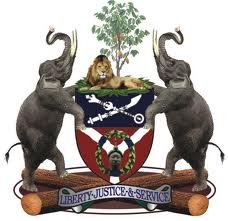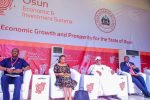By Olowogboyega Oyebade
Do you know that the State of Osun is a mobile gold mine in people and culture? Do you know that Baba OsundagbonuElebuibon of Osogbo is one of the few original Yoruba traditional icons in our world today? Are you aware that if his person, music, poems, books, predictions, portraits, pictures and reflexes are corporately packaged, we are good to smiling home with millions of Dollars from our white and black brethrens in diasporas? Do you know that house, works and tomb of SussanWenger lie as huge wastes as we are yet to unlock the lid plugging their revenue-yielding potentials as our cash-cows minting Euros from Germany and Austria? We need to study MEMEnomics.
Do you know that we are not in a hurry to acquire as monument the personal house of Baba Sala in Ilesa where he died? Are you aware that from the houses of Ogunmola, Duro Ladipo and Oyin Adejobi as monuments, we have got dollar-denominated museums? Do you know that the miracle-site of Prophet Babalola of the Christ Apostolic Church, the family houses of Moses Orimolade Tolase of the Cherubim and SheraphimChurch, Prophet Fakeye of Ayo Ni o Movement, Prophet Obadare, Pastor Adeboye, Pastor Kumuyi, Alfa Ajagbemokeferi, Alfa Sha Mashad are pleading to us for acquisition as our own oil wells for the future? What of the houses, documents and books of Oba Aderemi, Governor Fadahunsi, Oba Adenle of Osogbo, Oba Laoye of Ede and a host of other intellectual monuments scattered poorly in various communities without value-addition? We need to study MEMEnomics.
Do you know that we have to re-build all our sacred shrines without making religion to be a point of reference? Do you know that all the houses along the channels of Osun River are potentially dollar-denominated for tourists? Do you know that the water of Osun River could be bottled for sale to Osun devotees across the world? Do you know that our State is richer in resources than Israel and Saudi Arabia put together if we can think deeper? Do you know that we have to chart a new cause through MEMEnomics? Do you know that all the old churches mosques that we are demolishing are good monuments we must preserve to generate revenues for us now and the future generation? Do you know that our perspectives must grow as our environment is expanding?
Do you wonder why the trial of a Judge for misconduct could elicit ethnic reaction? Are you not shrilled at our failure to have true population census? Did you wonder why some people grew goose-pimples when we were to obtain ‘Sukuk’ loans for education in our State as the only thing they could see there was religion instead of the signature infrastructure that it brought later? Do you know that these base instincts are sign-posting our lower level of culture? Do you know that our State, as the repository of culture, must profit by it? Do you know that our State has no reason to be poor if we key into MEMEnomics? Do you know that this course must feature in the new Economic Summit that the Governor of the State of Osun, Mr GboyegaOyetola promised to convene in the first quarter of the year? Do you know that this is the only antidote to safe us from regrets and future apology like the fate of the mother of Nico Mbagawho acted to her son ignorantly, only to regret it and apologized later? Who was the mother of Nico Mbaga? What did she do? Come along, please.
Nico Mbaga was a Nigerian artiste of ‘high-life’ genre from Calabar. He released the popular top-chat label titled: ‘Sweet Mother’ in 1976.’ As a young lad, the father of Nico wanted him to go to school and stay glued to academic studies to earn a living. Nico became a truant and preferred to hang-out with some local musicians to play a minor character. The recalcitrance of this lad infuriated his father so much that the mother was invited to the waywardness of young Nico, as a cautionary witness. Out of anger and in the presence of Nico’s mother, Nico Mbaga was cursed by his father that he would never amount to much in life. The young boy escaped from the hostility at home to Cameroon to join some other music groups. To fast forward the story, the senior Mbaga died, believing so much in the efficacy of the curse he pronounced on his son. In 1974, as fate would have, he submitted the master-tape of his album ‘Sweet Mother’ to the producers. Alas! It was turned down on the excuse that it was ‘childish’. Nico saw his entire life crumbling. In a twist of fate in 1976, Nico Mbaga released ‘Sweet Mother’ which became one of the top chats in the music world. Dollars flew in. Prosperity for Mbaga arrived. He used part of the proceeds to purchase land in a choice location in Calabar to build a mouth-washing edifice for his mother as her habitation. Today, Nico Mbaga is an intellectual property for our country and the entire world. We must discern. At the reception organized to declare the edifice open, the mother of Mbaga sobbed:
“I shall tell my husband in heaven that he was wrong about Nico”.
Comrades! Culture is everything. Are you aware that economic, social and cultural rights are human rights? Do you know that they are recognised and protected in international and regional human rights instruments? Are you aware of Karel Vasak’stheory of rights? Do you know that he grouped rights into three generations? Yes! This categorization was initially proposed in 1979 by Karel Vasak at the International Institute of Human Rights in Strasbourg. He used the term at least as early as November 1977 which later took root in European law. Are you aware that his divisions followed the three watchwords of the French Revolution: Liberty, Equality, Fraternity? Do you know that they reflect in the rubrics of the Charter of Fundamental Rights of the European Union?
First-generation human rights are called “blue” rights. They deal with liberty and participation in political life. They are fundamentally civil and political in nature: They serve negatively to protect the individual from excesses of the State. Do you know that the first-generation rights include the right to life, equality before the law, freedom of speech, the right to a fair trial, freedom of religion, and voting rights? Are you aware that they were pioneered by the United States Bill of Rights and in France by the Declaration of the Rights of Man and of the Citizen in the 18th century, although some of these rights and the right to due process date back to the Magna Carta of 1215 and the Rights of Englishmen, which were expressed in the English Bill of Rights in 1689? Do you know that they were enshrined at the global level and given status in international law first by Articles 3 to 21 of the 1948 Universal Declaration of Human Rights and later in the 1966 International Covenant on Civil and Political Rights? Do you know that they were enshrined in the European Convention on Human Rights in 1953? Yes!
Are you aware that the second-generation human rights are related to equality and began to be recognized by governments after World War II? Do you know that they are economic, social and cultural in nature, including the right to be employed in just and favorable condition, rights to food, housing and health care, as well as social security and unemployment benefits? Do you know that they are also covered by the Universal Declaration of Human Rights, and further embodied in Articles 22 to 28 of the Universal Declaration, and the International Covenant on Economic, Social, and Cultural Rights? Yes!
Do you know that the third-generation human rights are those rights that go beyond the mere civil and social, as expressed in many progressive documents of international law, including the 1972 Stockholm Declaration of the United Nations Conference on the Human Environment, the 1992 Rio Declaration on Environment and Development, and other pieces of generally aspirational “soft law”? Do you know that the term “third-generation human rights” remain unofficial “green” rights including: group and collective rights, right to self-determination, right to economic and social development, right to a healthy environment, right to natural resources, right to communicate and communication rights, right to participation in cultural heritage, rights to intergenerational equity and sustainability?
Do you know that the African Charter on Human and Peoples’ Rights ensures many of those: right to self-determination, right to development, right to natural resources and right to satisfactory environment are contained in its provisions? Do you know that some countries have constitutional mechanisms for safeguarding third-generation rights? Are you aware of the Hungarian Parliamentary Commissioner for Future Generations, the Parliament of Finland’s Committee for the Future, and the erstwhile Commission for Future Generations in the Knesset in Israel? Do you know that some international organizations have offices for safeguarding such rights? Do you know that we have the High Commissioner on National Minorities of the Organization for Security and Co-operation in Europe and the Directorate-General for the Environment of the European Commission has as its mission “protecting, preserving and improving the environment for present and future generations, and promoting sustainable development”?
The International Covenant on Economic, Social and Cultural Rights (ICESCR) is the primary international legal source of economic, social and cultural rights. The Convention on the Elimination of All Forms of Discrimination Against Women prohibits discrimination on the basis of racial or ethnic origin in relation to a number of economic, social and cultural rights. The Convention on the Rights of Persons with Disabilities also prohibits all discrimination on the basis of the disability including refusal of the reasonable accommodation relating to full enjoyment of economic, social and cultural rights.TheUniversal Declaration on Human Rights (UDHR), adopted by the UN General Assembly in 1948, is one of the most important sources of economic, social and cultural rights as it recognizes the right to benefits of science and culture in Article 27.
The International Covenant on Economic, Social and Cultural Rights (ICESCR) is the primary international legal source of economic, social and cultural rights. The Covenant recognized and protects the right to participate in cultural life and the right to benefits of science and culture in Article 15. The International Covenant on Civil and Political Rights, adopted at the same time as the ICESCR, recognizes and protects a number of core economic, social and cultural rights, including the right to join trade unions in Article 22, and the right of ethnic, religious or linguistic minorities to engage in their culture, practice their religion and use their language in Article 27.
The Convention on the Rights of the Child recognizes and protects many of the economic, social and cultural rights recognized in the ICESCR in relation to children including the right to protection from economic exploitation. The ILO Conventions of the International Labour Organization (ILO) protect a range of work related economic, social and cultural rights. The African Charter on Human and Peoples’ Rights protects the right to education including cultural education in Article 17. The European Social Charter protects a wide range of economic, social and cultural rights. The Protocol of San Salvador protects a range of economic, social and cultural rights within the Inter-American human rights system.
The 1996 Constitution of South Africa includes economic, social and cultural rights and the South African Constitutional Court has heard claims under these obligations. It must be stated that economic, social and cultural right enshrined in international and regional human rights instruments are legally binding. Do you know that in 2008, the United Nations General Assembly adopted the Optional Protocol to the International Covenant on Economic, Social and Cultural Rights, which gives the Committee on Economic, Social and Cultural Rights competence to receive and consider communications from individuals claiming that their rights under the Covenant have been violated by a State party. Do you know that the Protocol entered into force on 5 May 2013? Do you know that the imports of these laws is to emphasis the stake of culture? We need to study MEMEnomics to make the best use of Cultural Economics. Come along, please.
We remember Said E. Dawlabani. He is a cultural economist. He authored the 2013 book titled: “MEMEnomics:The Next-Generation Economic System”. The book provides the first framework that explores the effect of economic policies on culture. This is MEMEnomics in action. Do you know that new technologies have also led to cultural convergence where all kinds of culture can be accessed on a single device? Do you know that in a single smartphone, we can share books, music, talk, artwork and more can all be accessed on a single device in a matter of seconds? Do you know that as a nation, we attract to ourselves negative fame as internet fraudsters than the positive fame we deserve from the exploits of our Nollywood stars? Do you know that the time to study MEMEnomics? Are you aware that our State is rich in culture? Do you know that we can promote prosperity for all if we tap into it? Do you know that one sure way to open the lid to this prosperity is to introduce Cultural Economics into the curricula of High Schools and tertiary institutions in our State for sustainable development in MEMEnomics? What is sustainable development in this context? Come along, please.
We remember David Throsby, an economist. He proposed the idea of culturally sustainable development. According to him, the cultural industries must have policy prescriptions that can guarantee and ensure growth for future generations. He prescribed the advancement of material and non-material well-being which implies balance amongst economic, social, and cultural forces, inter-generational equity and the maintenance of cultural capital by making current generation to recognize their responsibility to future generations, equity within the present generation by making sure that distribution of cultural resources is fair and recognition of interdependence by making policy to understand the connections between economic, cultural and other variables within an overall system. With these guidelines, Throsby hopes to spur the recognition between culture and economics, which is something he believes has been lacking from popular economic discussions. Do you know that Culture and Economics work together? Do you know that is the flagship of Cultural Economics? Come along, please.
Cultural Economics is the branch of economics that studies the relation of culture to economic outcomes. It is a growing field in behavioral Economics that studies the role of culture in economic behavior. This new field of studies investigates religion, social norms, social identity, fertility, beliefs in redistributive justice, ideology, hatred, terrorism, trust, family ties, long-term orientation, Management of Museums, Arts Market, and the control of religious sites and monuments to promote culture. The theme course is how ideas and behaviors are spread among individuals through the formation of social capital, social networks and processes such as social learning, as in the theory of social evolution and information super-highways. The methods adopted by the course include case studies and theoretical and empirical modeling of cultural transmission within and across social groups.
Cultural economics demonstrates how preferences can be shaped socially. In this sense, the interdependencies of culture and the economy can be combined. An area that cultural economics has a strong presence is sustainable development which has been defined as “…development that meets the needs of the present without compromising the ability of future generations to meet their own needs…”. Culture plays an important role in how people view preparing for these future generations. Do you know that the idea of Future Sovereign Wealth Fund is a brain child of Cultural Economics?
Do you know that our State should cash in on the traditional Yoruba religious practices prevalent in South America, West Indies and North America by hastily package and promote religious tourism titled: “KareleOodua.”? Do you know that we need to promote the economic benefits of Osun Osogbo Festivain Osogbo, Iwude in Ilesa, Olojo in Ife and Sango Festival in Ede? Do you know that we have to collectively partner with Nike Arts Gallery to create more opportunities for our graduates? We must create opportunities to study the economics of creation, distribution, and the consumption of works of art, literature and similar creative and/or cultural products from our State to any part of the world.
Do you know that with our partnership with Nike Art Gallery, our State Cultural Troupe can be exportable? Do you know that the ‘Ijala’ of Asunmo, a lead-vocalist in the troupe, can bring millions of Dollars to him and our State? This is MEMEnomicsat play. Without it, we are a huge waste. The earlier we direct all civil servants in the State to change their official dresses to our Ibile brands, the better.
Works of art and culture have specific quality which is unique. The various abandoned sculptures, stone casts in some of our palaces should be given face-lifts to generate revenues. School excursions must be encouraged. Banks operating in the State may be encouraged to assist in the renovations of our monuments as part of their corporate social responsibility. They can equally be encouraged to invest into our art works and promote art auctions. It is such intervention that can mitigate the harshness in uncertainty of value in cultural markets. Interventions of commercial institutions will make a difference. The short life cycle of some art works is a constraint. Most cultural items are sold/traded shortly after their introduction or production. Some cultural goods, such as broadcast news, have little or no market value shortly after the broadcast. Of course, some cultural products may retain saleability for years or even decades. Extra interventions will regulate the market.
Art market can be dominated by a few major companies or Cooperative Societies. The Insurance Companies should be invited into the business to minimize risks. Artists can be encouraged to synergise to gain market power to create threshold profitability to stay in the business. Our Economics of Cultural Heritage must teach us Management and regulation of museums which have conservatory roles and provide exhibitions to the general public. Do you know that in many countries, historic buildings such as cathedrals and big mosques are considered to be “heritage buildings” and as such they are protected against demolition or substantial modifications? We must key into MEMEnomics.
Many countries have systems that protect historically significant buildings and structures. These are buildings or other structures that are deemed to have cultural importance or which are deemed to have heritage value. Owners get tax deductions or subsidies for restoration, in return for which they accept restrictions on modifications to the buildings or provide public access. Buildings that are often classified as heritage buildings include former or current Parliament buildings, cathedrals, court-houses, houses built in a recognized historical style, and even fairly regular houses, if the house was formerly the home of a famous politician, artist or inventor. Buildings with heritage status cannot typically be demolished. But here, we are yet to provide for the laws to regulate the development of our monuments. Do you know that our burial grounds can be turned to museums to generate revenues? Do you know that burial grounds should be decorated to invite tourists and generate revenues from them? This is MEMEnomics.
Do you know that our Nollywood Stars contribute more to our GDP than all the researches of our universities put together? Do you know that the remittances of our sportsmen in diasporas are more than what we are realizing from our solid minerals? Do you know that if we promote our local football leagues, our GDP will jump-start astronomically? Do you know that we can earn billions of Dollars by promoting our Yoruba cuisine? Do you know that our Suya can be exported? What of Elubo? What of palm-wine?
Do you know that we can export ‘Agbada’ and ‘Fila’? Do you know that we can export Iro and Gele? Do you know that we can export Aso-Ofi? Do you know that we can export our drums such as ‘bata’, ‘gangan’, ‘omele’ ‘sekere’ to mention but a few? Do you know that we can export our masquerades? We must create serious interfaces with the Nigerian Investment Promotion Commission to get more information. This is the way to MEMEnomics. This is the way to prosperity. We join millions of people to appreciate our Governor Mr Gboyega Oyetola for thinking out of the box to promote prosperity in our State. Let us prepare to participate very well in the forth-coming economic summit. As we await that, let us stop demolishing our old cathedrals, mospues and other vital cultural monuments in our communities. Osun a dara.









